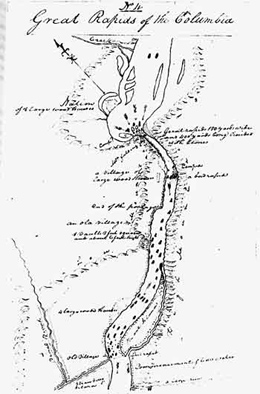In about 1450, an immense landslide tumbles off Table Mountain in Skamania County and completely blocks the Columbia River, shoving it a mile off course. A lake forms behind the dam extending as far as 100 miles. The river will eventually breach the dam causing a 100-foot-deep flood downstream and creating the Cascades rapids. This is the most recent of four documented slides in the 14-square-mile Cascade Landslide Complex and will be called the Bonneville Landslide.
Table Mountain consists of Columbia Basalt on top of a softer clay-filled formation. "What you've got is a deck of cards that is pointing and sliding toward the river," said Alex Bourdeau, an archaeologist with the U.S. Fish and Wildlife Service (Hill). Perhaps because of seismic activity, soil and rocks slid off the mountain and into the river, creating a dam 5 1/2 square miles in area and 200 feet high -- three times the height of Bonneville Dam. Some rocks were 800 feet long and 200 feet thick.
The lake drowned trees along the river for 35 miles. Some time later, perhaps years later, the river breached the dam and flooded downstream to a depth of 100 feet as far as the future Troutdale. The breach became the Cascades of the Columbia, four miles of nearly continuous rapids that explorers Lewis and Clark called "the Great Schute" (O'Connor).
Radio carbon dating of trees drowned by the lake placed the event between 1550 and 1750. A geologist recorded in 1869, "The Indians say these falls are not ancient, and that their fathers voyaged [from the sea] without obstruction in their canoes as far as The Dalles" (O'Connor).
It is unknown if there were any human casualties of the cataclysm, but the creation of The Cascades was a boon to Native Americans. The rapids made the location ideal for catching salmon during the summer runs and became central to the local economy. The floods also created extensive sandy beaches downstream.
The slide also helped create a local legend about the Bridge of the Gods. Journalist Richard Hill described the story this way: "Wy'east (Mount Hood) and Pahto (Mount Adams) were powerful braves, the sons of Old Coyote. They both fell in love with a maiden (Mount St. Helens), and they frequently crossed a bridge over the Columbia to fight each other. Coyote caused the bridge to collapse in an effort to keep the feuding brothers apart."
In 1929, a steel Bridge of the Gods connected Oregon and Washington over the Cascades. In 1938, Bonneville Dam flooded the Cascades and the Bridge of the Gods had to be raised to accommodate shipping on the new lake formed behind the dam.

